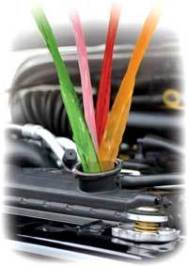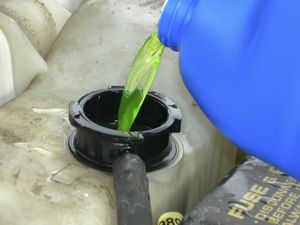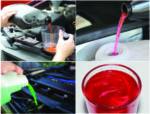The Different Colors of Coolant
“The coolant is one of those fluids that everyone ignores and ends up being forgotten and used for years and years in the car’s cooling system. Not many know the importance of the different colors that are available today. Let’s learn more.“
 The Different Colors of Coolant
The Different Colors of Coolant
If an engine is used without coolant (antifreeze), it can suffer extended damage especially during winter. In the summer time, cooling can be obtained using plain water in an emergency situation although not recommended much beyond this since it’s much easier to boil over as well. Also in wintertime, water solidifies (freezes) and expands in volume which can crack your engine block, radiator and heater cores. This is the reason coolant is mixed with distilled water in a minimum 50/50 proportion. It lowers the freeze point of the coolant to protect it from freezing, even in the worst winter conditions. Coolant in the summer time works as an anti-boil and protects the system components from corrosion, which is a big deal especially with aluminum components.
What are the benefits of using coolant?
Has the role of helping the engine to cool in the summer time (it keeps the engine from boiling over). Also protects the engine from freezing during winter.
However, besides these well known benefits, there are also others worth mentioning:
- Anti-corrosive. (The fluid will not attack the metals it comes in contact with and it won’t destroy it over time)
- Prevents deposits. (Prevents limestone deposits and others similar to it which could reduce the cooling system’s efficiency)
- Anti-foam. (Coolant has special additives in it that prevents foam from forming. If foam appears, the cooling system’s efficiency might be reduced)
How often should the coolant liquid be changed?
Theoretically it should be good for an indefinite period. This is in theory, however in real world conditions, regardless of it’s quality, coolant (antifreeze) should be changed once every 2-5 years (average time after which it loses much of its benefits, unless specifically formulated as ‘lifetime’ on the bottle).
One should not forget to change their coolant because in the winter time, the engine can suffer irremediable damage.
Coolant (Antifreeze) liquid is tested using a device called an Antifreeze/Coolant Tester. This can be found at any car shop/parts store or online. Another option is just to simply ask the mechanic to test your coolant efficiency before winter settles in.
How many types of coolant liquids are available?
Coolant (Antifreeze) can be found in more than 1 color. This can be confusing for people who don’t know what each color indicates. We will break it down for you to better understand why this liquid comes in a multitude of colors. Colors include blue, yellow, green, red, pink, turquoise, orange and purple.
Because a vehicle can pretty much run any type of coolant which is safe for aluminum, you should consider the type depending on the kind of protection you’re seeking from it(prevents corrosion and preserves the metals and aluminum parts) and also depending on how often you desire to flush your coolant system.
There are 3 types of coolants:
 Inorganic Acid Technology (IAT)
Inorganic Acid Technology (IAT)
Commonly used in the cars produced in USA between 1920 and 1990.
This contains silicates and phosphate corrosion inhibitors to protect metal parts such as the radiator and engine.
Usually found in a bright green color, it is recommended to be flushed out of the cooling system every 30,000 miles or every 2 years. It’s typically used in older cars manufactured before the mid 1990s ( Domestic vehicles from ’20s to ’90s, GM, Ford, Chrysler)
Organic Acid Technology (OAT)
Present in newer cars all over the world, OAT coolant color ranges from pink, orange, bright red, red, blue and dark green.
Organic Additive Technology as it is referred to in some owner’s manuals, is the same as Organic Acid Technology, unless your owner’s manual says differently. Both are considered an OAT Antifreeze / Coolant. They use carboxylic acids as the ‘additive’, to inhibit corrosion.
These antifreeze /coolants do not contain silicates or phosphates, however OAT coolants contain corrosion inhibitors that enable it to last for a much longer period of time. Special additives are used to prevent rust and corrosion, however metal parts could support some wear in time. It is recommended to be flushed out of the cooling system every 135,000 miles or every 10 years. Typically used in newer cars. While usable in older model cars also, it is best to check the owners manual to make sure that OAT coolants would be safe and effectively used. (Typically used in Chrysler, GM, VW, Honda, Mitsubishi, Nissan, Toyota)
As a side note, if you own a Chrysler (Jeep, RAM, etc.) vehicle that calls for OAT Coolant in your owner’s manual, such as Mopar 68163849AB – 50/50 Prediluted 10 Year Antifreeze / Coolant… your local Chrysler, Dodge, Jeep, RAM dealer may have the best price and availability in their parts department. Many people have found this to be the case.
 Hybrid Organic Acid Technology (HOAT)
Hybrid Organic Acid Technology (HOAT)
A mix between IAT and OAT coolants, it is designed for new cars. This contains added silicates that increase aluminium protection and prevents corrosion. Additives are also present to prevent rusting. To differentiate these a little easier, HOAT coolants are found in yellow, turquoise, pink, blue or purple colors.
It is recommended to be flushed out of the system every 150,000 miles or 5 years. (Typically used in Major European, German and Asian car manufacturers, some Chrysler vehicles)
Rule of thumb, if your car was born with a specific coolant color, you shouldn’t change it. OAT works great in systems that were built for it but does poorly in old-style radiators that use lead solder. It tends to attack and eat (destroy) the radiator from the inside-out and works too slowly to protect the radiator from corrosion. However this doesn’t happen overnight, it might take some time until your radiator is damaged.
Important to remember is that conventional and OAT coolant types don’t go together. Never mix them together in your radiator unless specifically designed to be mixes with other types, because in the long run it can end up destroying your system.
Also pay attention to the coolant system capacity as written in your owners manual. Proper coolant level is important. Having less in the system than the designed capacity lowers efficiency and can result in overheating.
Mixing different coolants together does not boost their benefits. For example adding OAT/HOAT to a IAT coolant does not provide the IAT coolant with a longer life, however it cancels OAT/HOAT benefits and makes the mixed concoction only good up to a maximum of 2 years or less in some cases. Also it is believed by some that mixing coolants in a radiator might lead to coolant gelling in the right unfortunate circumstances.
How to prepare your coolant?
Coolant comes in a concentrated formula and needs to be mixed with water at a 50-50 ratio for it to work, unless it is marked otherwise and already premixed for you. Even if modern coolants are able to work with today’s level of chlorides and hardness found in tap water, users are advised to create the mix using distilled water to reduce corrosion levels.
Tap water contains magnesium, calcium and hardness ions that contribute to scale and deposits in your radiator that reduce cooling efficiency. Also it contains chlorides that can be very corrosive.
When mixing coolant and distilled water together, carefully follow the percentages on the bottle depending on your specifics. (for example, if winters are harsher, most coolants recommend a mix of 40% distilled water and 60% coolant)
Best practices
When you decide to change your antifreeze/coolant liquid make sure you replace it with the same color or that your car is compatible with other colors (see owner manual).
When changing the coolant, it is best to drain it all and then top off with water/distilled water, start the engine and let it circulate completely and then drain again. For best results, this should be done 2-3 times. This helps evacuate the coolant from even the deepest parts, nooks and crannies of your cooling system and also helps dislocate any old deposits that might have formed.
Add the new coolant using the tips above and make sure you at least follow the 50-50 ratio. Best would be to read the instructions on the label to prepare the PERFECT mix.
Even though it may sound good or even tempting to add more coolant than water, in reality this reduces the efficiency of the coolant liquid.
In order to reduce the risk of deposits and to keep the protection levels high, it is recommended that the system is heated and circulated at least every 30 days. This applies to all coolant liquids.
About the Author
Tech Guy
Automotive enthusiast, passionate about Jeeps, hot-rods, turbos, performance, efficiency, diesels, fuels, high performance oils, additives and anything with an engine.

